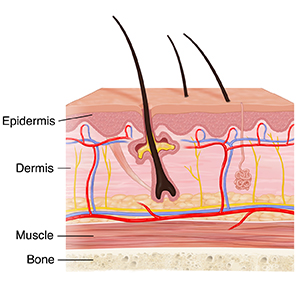Burn Emergencies
Electricity, chemicals, steam, very hot liquids, fire, and radiation including from the sun can all cause serious burns. The care you receive for burns will depend on the type and severity of your injury. Many burns can be treated in an outpatient setting. If a burn needs inpatient treatment, it should be done in a burn center. Very severe burns need treatment in a burn center.
Types of burns

You may be most familiar with the traditional burn classification of first-, second-, and third-degree burns.
-
First-degree burns are usually mild. They affect only the outer layer of skin (epidermis). The skin is likely to be red, and there may be some pain and swelling. Most sunburns are first-degree burns.
-
Second-degree burns injure the second layer (dermis) of skin. The skin will be intensely red and may develop blisters. These burns are often very painful.
-
Third-degree burns involve all the layers of skin. Fat, nerves, muscles, and even bone may be burned. The skin may be charred black or appear very white. Pain may be severe. Often, nerves are damaged. When that happens, you will feel no pain at all.
A newer classification uses designations based on the depth of the burn and the need for surgery:
-
Superficial burns involve the outer layer of skin (epidermis). They are painful and red, but don't blister.
-
Superficial partial-thickness involves the outer layer and second layer (dermis) of skin. These burns usually blister within 24 hours and are painful, red, and weeping.
-
Deep partial-thickness burns extend into the deeper dermis and damage hair follicles and glandular tissue. The burn is painful on pressure, and the blister is wet or waxy and mottled or patchy in color.
-
Full-thickness burns extend through all layers of the skin and often to the underlying tissue. Blisters don't develop, but skin can vary from waxy white to gray to charred and black. They are usually painless or numb.
-
Fourth-degree burns are deep and can be life-threatening, extending through skin into underlying tissues, muscle, or bone.
When to go to the emergency room
Go to the emergency room or call 911 right away for:
-
Second- or third-degree burns
-
Burns all the way around an arm or leg
-
Burns caused by electricity or chemicals
-
Burns involving the eyes, mouth, or airway
-
Any burn that covers large parts of the body
-
Severe burn to the hands, feet, and face
If you have not had a tetanus shot in the past 5 years, you may need a tetanus booster vaccine, depending on how serious the burn is.
What to expect in the emergency room
Some activities that will happen include:
-
You will be given medicine to relieve pain.
-
Your clothing will be removed.
-
The healthcare provider will use moist cloths to cool the burn.
-
If you have a chemical burn, they will flush it with water and may inject medicine. If your clothing is sticking to the burn, flushing it with water helps release the clothing.
-
They will wash the burn and remove any damaged tissue. They may apply antibiotic ointment and cover the burn with a dressing.
-
If needed, you will be given fluids through a vein by IV (intravenous) in the arm or other limb not affected by burns. (This is usually for large burns.)
-
If you inhaled smoke, your airways may be burned. If so, they may place a tube in the windpipe (trachea) and connect it to a breathing machine (ventilator) to help breathing. You may have a chest X-ray to look for damage to the lungs from inhaling smoke. Blood tests may be done to check the body’s levels of oxygen and carbon dioxide.
Follow-up
Some burns can be cared for at home. Burns easily become infected, so careful cleaning and dressing changes are important. Very deep burns often require long-term medical treatment. For these burns, treatment is done in a burn center. Depending on the severity of the burn, skin grafts may be needed to replace damaged tissue.